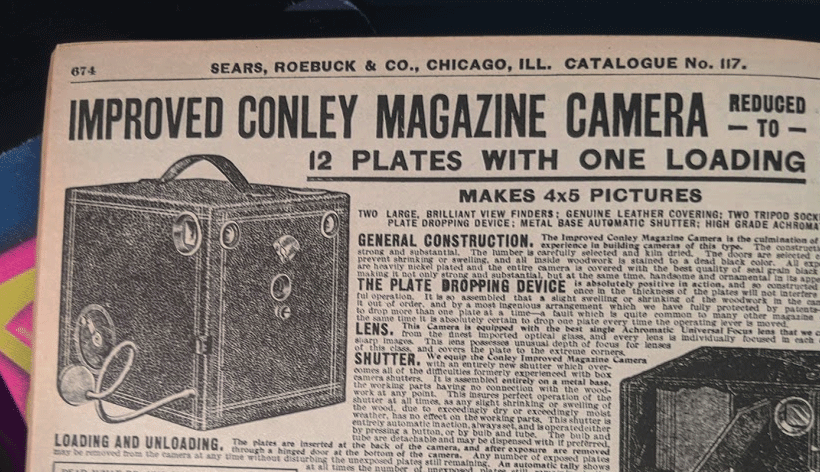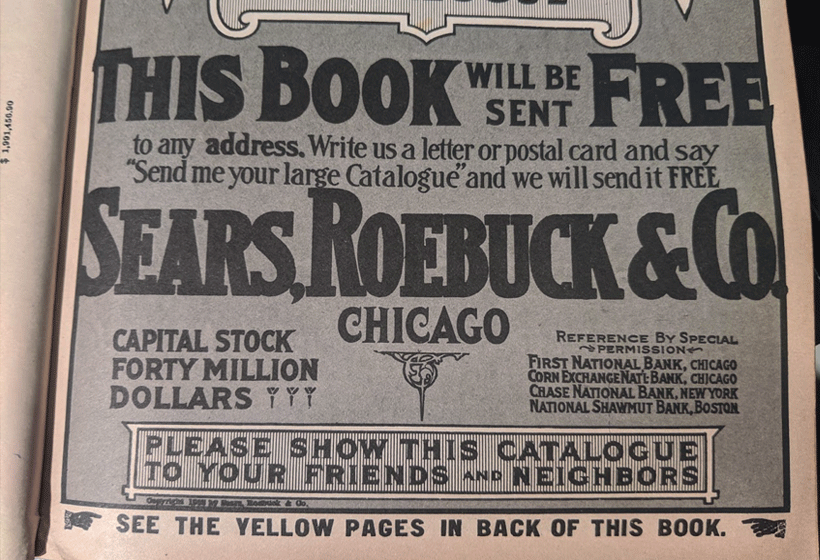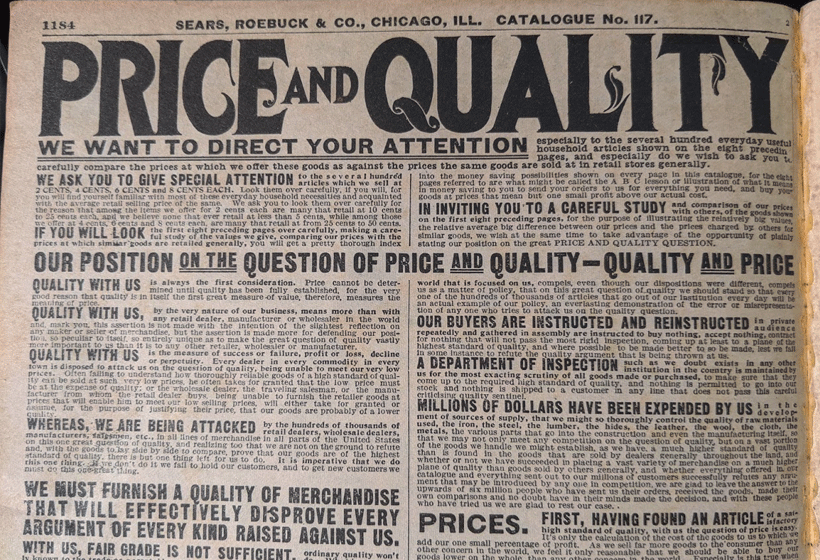I recently purchased a vintage Sears Roebuck catalog to display on a shelf in my office. My thinking was, what better conversation starter would there be for other marketers visiting my office than the display of a decades-old catalog that pioneered many of the direct mail techniques we still use today?
Sadly, I made the mistake of letting my 8-year-old son look through the catalog shortly after purchasing it, and minutes later the aged paper cover had been torn off. Despite the damage, the catalog holds a trove of powerful marketing lessons inside that got me thinking about how the world once used direct mail, and about what we can learn from it as direct mail is reborn as a “new” (and yet so old!) method of marketing.
Having worked with dozens of clients who are still using direct mail successfully today, I’ll apply the lessons I’ve learned with those campaigns and pull in some techniques pioneered by Sears in their Sears Roebuck catalog as well. The following five direct mail takeaways can assist you in your marketing efforts — but first, let’s look at the history of Sears’ famous catalog.
History of the Sears Roebuck Catalog
Fueled by an enormous migration in the USA of homesteaders moving West in the mid to late 1800s, and assisted by the steady expansion of the railroads and national postal service, the time was right for mail order business. On this stage, in 1888, when Richard Sears put together his first printed mailer to sell watches and jewelry, the Sears Roebuck Catalogue (yes, that is how they spelled it at the time) was born.
The original catalog mailer was a small 6×9-inch format but was increased to the better known 8×11-inch format in 1896. About that same time, the catalog was expanded to sell all variety of goods, including sewing machines, musical instruments, horse-drawn buggies, and baby carriages.
The catalog continued on for over a century, eventually selling such items as automobiles, appliances, baby chickens, and groceries. In 1993, the Sears Roebuck Catalog was discontinued, and Sears began to mail out standard small format mailers and catalogs like their competitors were doing.
5 Direct mail marketing lessons you can learn from the Sears Roebuck Catalog
It’s no coincidence that Sears was the leading retailer for decades. Even when they moved to a brick-and-mortar format, their Sears Roebuck Catalog paved the way for their success by winning loyalty from the many consumers who received the catalog in the mail, leading to successful lead generation.
Here are five marketing lessons we can learn from the direct mail success of Sears Roebuck:
1. Successful direct mail requires a quality product
If you have the mailing address of your prospective customer it is likely that they already know something about your company and brand. No matter their prior interactions, each direct mail piece you send can be one that creates a fresh perspective about the quality of your brand.
For this reason, make sure the actual card/letter/package you are direct mailing is high quality (see tip #5) and make sure you’re explaining, in short and precise language, why your company, product or service is high-quality and worth their time. Sears Roebuck used a simple “Your Money Back if You Are Not Satisfied” reassurance to potential buyers, winning their trust and ensuring a high-quality product.
2. Incentivize sharing with social calls to action
In 1897, nine years after the first catalogs were mailed, Sears Roebuck created a program to incentivize sharing the catalog with friends and neighbors. On the front of most of their catalogs were printed the words “Please show this catalog to your friends and neighbors” and inside each catalog included details about their new “Club Order Program” whereby friends and neighbors could combine their orders for significant discounts.
Fast forward a century, and we’re still seeing successful marketing campaigns that implement sharing calls to action. If you’ve spent much time on social media sites you may have seen examples of companies using social paywalls for lead generation. In short, a company gives away valuable content to any consumers who are willing to share a message of support on their social network.
One way of implementing a similar tactic in your direct mail campaign is to include a quick share QR code, which when scanned, pre-populates a social media message that your direct mail recipients can share via their phones. You can then use an easy-to-set up third-party app, like IFTTT, to auto-reply to these social media shares with a link to your free content.
3. Customize and personalize your direct mailers
While not exactly personalized, Richard Sears often included a page in the catalog with a handwritten note (which was then mass-printed) to the consumer. In doing so, he created a greater bond with his customers, one of the reasons why Sears Roebuck went on to be a leading retailer for a century.
Here’s an article (see tip #3) that shares some more ideas on how to make a strong impression with handwritten notes.
In helping one of my previous clients find a way to connect with busy small business owners, we launched a successful handwritten direct mail campaign. We hired part-time workers to handwrite a short message inside a greeting card. The handwritten interior and exterior (mailing address) made a great impression, but we took it a step up and included a personalized URL, which contained the recipient’s first name, as the call to action.
Needless to say, this highly custom and personalized direct mailer had a response rate (people visiting their personalized URL and personalized landing page) of between 20 and 30 percent, depending on the quality of our mailing list.
4. Provide value
For customers living in rural areas, far from any big-box department stores that could only be found in the largest cities, receiving a 1,000+ page catalog in the mail was a real treat in the early 20th century. The earliest Sears Roebuck Catalogs were mailed for free, but in 1896, they started charging a 25-cent fee. However, understanding the need to provide the highest value to the consumer, Richard Sears applied that 25-cent fee back as a discount to any purchases over $10.
Similarly, with the wide variety of advertisements your potential customers are seeing each day, it is important to provide something of value to your buyers to first pique their interest. Due to the offline nature of walking to a mailbox and finding something inside, simply sending a postcard with a promotional offer may be enough to excite your customer.
I’d recommend you up your game though and try to offer something of greater value. For example, prior to the holiday rush shopping period last year, Amazon shipped out a 100-page printed catalog that was loaded with gift ideas for children.
They also included fun stickers that could be applied by the children in your home to mark desired gifts. This catalog was a big hit with my 8 and 10-year-old boys, providing enormous value and a significant WOW factor for my wife and I… turning us into even greater Amazon junkies.
5. Go beyond flat mailers
While sending postcards are attractive to marketers on a budget, going beyond the simple can make leave a great impression with your prospective buyers. For an early example of this, let’s take another look at Sears Roebuck. In 1905, the catalog began to include full color and highly-textured samples of wallpaper and fabric swatches of men’s suits material. We can only imagine how little touches like this left a big impression on the prospective buyers of the time.
In our modern age, where consumers are often sick and tired of seeing digital ads, providing a tactile marketing response can go a long way in winning a new customer. Think about sending something that isn’t just a flat mailer.
If you can justify a targeted direct mail send, and include something meaningful like some company swag, the chance that you’ll have a sales call or land a deal with that prospective customer goes up dramatically.
Reach your prospective buyer with direct mail
With the advent of digital marketing, many firms put so much effort into the new marketing media that they began to neglect direct mail. However, companies are now wising up to the potential of direct mail.
In fact, Canada’s Postal system published research which found that direct mail requires 21 percent less cognitive effort, compared to digital media, indicating it is more memorable to the consumer. Additionally, their research showed that consumers who had received a direct mail piece were able to recall a brand 75 percent of the time, compared to only 44 percent recall for digital-only impressions.
Not to be outdone by our neighbors to the North, the United States Postal Service has recently released research indicating that direct mail is working with a variety of demographics, including the otherwise hard to reach and influence millennial age group.
According to their research, 59 percent of millennials find the information they receive in the mail to be more useful than what they receive via email. A finding that holds more potential draw for marketers is that 80 percent of millennials look forward to seeing what they’ve received in their mailbox.
Regardless of your other marketing efforts, or who you’re selling to, direct mail holds great potential for any marketers who are able to innovate. Sears Roebuck built a booming business for over a century on the back of a catalog. Innovative direct mail marketing can provide you great results too.






